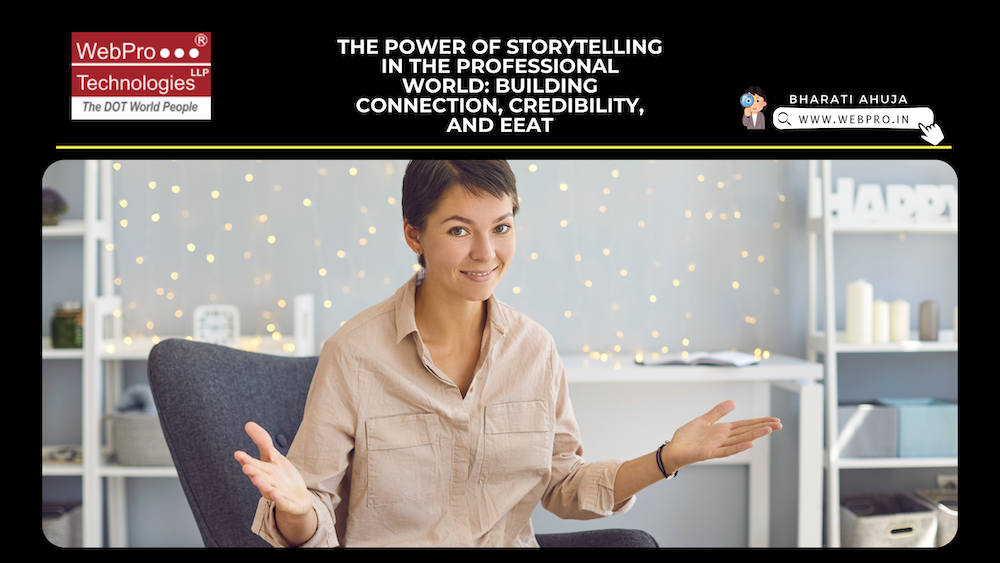In today’s digital-first world, where every business and professional is vying for attention, storytelling has emerged as more than just an art—it’s a strategic necessity. Data, facts, and technical specifications still matter, but they are no longer enough to create impact on their own. What sets apart a brand, a leader, or even a professional profile is the ability to tell a story that resonates, inspires, and builds trust.
Whether in boardrooms, on LinkedIn, or through company websites, storytelling gives life to ideas and makes them memorable. It’s no coincidence that some of the most successful brands and thought leaders are also powerful storytellers. They don’t just share what they do; they share why they do it, how it impacts people, and what journey brought them there.
Facts inform, but stories influence. And yes, we are living in the age of influence.
Today, influence is currency. We live in a digital era where narratives spread faster than raw information. Influencers build entire careers not just on the basis of what they know, but on how they tell their stories. Brands thrive when they wrap their products in narratives that resonate with their audience. Leaders inspire movements not by quoting numbers, but by sharing stories that ignite belief.
In this age of influence, attention is fragmented and trust is scarce. Facts alone can get drowned out in the noise. But stories — authentic, relatable, and well-crafted — cut through, shaping opinions, driving decisions, and building lasting loyalty.
In the Personal Sphere
- Human connection: Stories help people bond. Sharing personal experiences makes conversations authentic and relatable.
- Memory and meaning: Our brains are wired to remember stories more than facts. A life lesson wrapped in a story stays with us longer.
- Identity and values: Telling stories about our experiences, family, or culture helps us define and express who we are.
- Emotional resonance: Stories stir emotions, making them powerful tools for empathy and trust-building in relationships.
Why Storytelling Matters in the Professional Sphere
- Leadership and Vision
Leaders who tell stories don’t just present strategies; they inspire teams with a sense of purpose. A story about overcoming challenges or innovating against the odds can motivate people far more than a spreadsheet of quarterly results.
- Marketing and Branding
Every brand has a backstory—how it was born, who it serves, and why it exists. When this narrative is told effectively, it helps customers connect emotionally with the brand. People may forget slogans or taglines, but they remember stories of origin, customer success, and transformation.
- Professional Growth
Individuals, too, benefit from storytelling. Sharing personal career journeys on professional platforms can highlight resilience, adaptability, and expertise. This kind of narrative not only strengthens one’s personal brand but also builds credibility among peers and potential employers.
Storytelling and Website Content: The EEAT Advantage
In the digital landscape, especially when it comes to websites, storytelling plays a crucial role in how content is perceived and ranked by search engines. Google emphasizes EEAT (Experience, Expertise, Authoritativeness, Trustworthiness) as a key framework for evaluating content quality. Storytelling directly supports these pillars:
- Experience: Sharing real-world stories—case studies, customer journeys, founder stories—demonstrates lived experience. For example, a consulting firm showcasing how it solved a client’s problem tells a stronger story than a dry list of services.
- Expertise: When industry professionals weave storytelling into content, it showcases not just what they know, but also how they apply their knowledge in real scenarios. A “how we did it” narrative conveys expertise in action.
- Authoritativeness: Stories supported by verifiable data, testimonials, and outcomes strengthen authority. A detailed success story backed by client feedback positions the website as a trusted resource in its niche.
- Trustworthiness: Authentic stories humanize the brand. When users read genuine accounts—like a founder sharing failures before success, or a business describing its ethical practices—it fosters transparency and builds trust.
By embedding storytelling into website content, businesses can transform their online presence from being merely informational to being truly impactful. Instead of sounding like another generic website, they stand out as authentic, knowledgeable, and trustworthy.
From Data to Narrative: Why Stories Stick
Neuroscience research shows that while facts appeal to the logical brain, stories engage both the emotional and cognitive centers. When we hear a story, we don’t just process the information; we experience it. For professionals and businesses, storytelling is a proven method to make messages memorable.
Practical Ways to Incorporate Storytelling into Professional Content
- Case Studies: Share not just the results but the journey—challenges faced, solutions tried, and lessons learned.
- About Pages: Go beyond company history. Tell the story of the mission, values, and people behind the brand.
- Blogs & Articles: Frame industry insights through real-life examples, anecdotes, or customer experiences.
- Testimonials: Encourage customers to tell their stories, not just give ratings.
- Thought Leadership: Professionals should share their career stories, experiences, and perspectives, positioning themselves as relatable and authoritative voices.
Point To Ponder on…
In the professional world, storytelling is no longer optional—it’s a differentiator. It influences how leaders inspire, how brands connect, and how professionals grow their credibility. More importantly, in the digital era, storytelling strengthens the EEAT factor, helping websites not just attract visitors but also earn their trust.
When information is everywhere, stories are what set you apart. They don’t just tell people what you do—they show them why it matters. And that, in both business and personal growth, makes all the difference.
September 17, 2025







